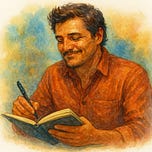We’re not wired to thrive on a diet of despair.
Yet every waking second we receive a steady stream of anticipation, anxiety, FOMO, shame, inadequacy, outrage, moral superiority, loneliness, need for belonging, validation, ego gratification, and desperation. (That list is not random.)
These harmful technologies, news cycles, and societal meltdowns don’t hijack random feelings1.
They target precisely the emotions that govern attention, reward, and identity.
It is not a “dopamine detox” that will resolve this exploitation of your identity. More than anything, you need a challenge that matters and the conditions to meet it2.
We tend to believe that the best way to manage uncertainty is to plan harder, control more, and work faster. But the science says otherwise.
What if the secret to thriving in complexity isn’t tighter grip—but deeper presence?
Enter flow—a psychological state where focus sharpens, self-consciousness fades, and effort feels effortless. You’ve felt it: writing a sentence that seems to write itself, solving a problem without overthinking, losing track of time in conversation or code.
This state isn’t just something useful for artists or engineers—it’s foundational to flourishing. This process is so intrinsic to humanity that it produces a profound sense of joy3.
Yet the question isn’t what flow is. The question is: How do we get there more often—especially when life feels unpredictable?
In the decades since flow was first studied, the research has evolved—expanding, deepening, revealing how flow is not simply a state of pleasure but a discipline for thriving in complexity.
Why Your Best Thinking Happens When You Stop Trying to Think
Flow arises most reliably when feedback is immediate and goals are clear, whether in sports, surgery, or software4.
In complexity science, control often backfires. The more we try to force outcomes, the more fragile systems become5.
The same is true in our minds. In a landmark study, Charles Limb scanned the brains of musicians improvising in real-time. When they hit flow, the self-monitoring parts of the brain—like the dorsolateral prefrontal cortex—quieted down¹. Their inner critic stepped aside so creativity could take the lead.
Flow happens when you stop trying to manage experience and start meeting it.
Why We Need Flow Now More Than Ever
Our attention is fractured. Our nervous systems are overloaded. The news is designed to alarm, not inform.
Without flow, we default to what psychologists call “ego depletion”—decision fatigue, overthinking, and emotional exhaustion.
And sometimes, the most resilient thing you can do… is surrender the need to control6.
Yet when people find flow, they report more meaning, less stress, and greater energy—even under pressure. Flow doesn’t remove uncertainty. It rewires how we respond to it.
In a world obsessed with optimization, flow reminds us that some of the best things can’t be forced—only invited.
In team settings, shared flow even predicts better collaboration, faster problem-solving, and fewer interpersonal conflicts². The best teams aren’t just high-performing—they’re coherent. Their attention moves as one.
For leaders, the most effective are not the most controlling, but the most responsive.
Money As River, Not A Dam
Most people treat money as a dam—accumulate, restrict, hold. But in uncertain environments, that rigidity can create fragility. When money is seen instead as a flow of value, not a stockpile of worth, you engage it differently:
You move with opportunity, rather than freeze in fear.
You invest in relationships, skills, or ideas that create momentum.
You release old financial identities and instead ask: Where is the energy moving now?
This aligns with adaptive market theory, which suggests flexibility and learning over fixed strategies are key to financial survival7.
The Takeaway
Flow is not a retreat from reality, but a reorientation. It’s not a hack for productivity—it’s a path to presence. We don’t flow through uncertainty. We flow with it. That’s the heart of Adaptive Resilience: meeting life as it is, with skill sharpened by surrender.
How To Try It
Instead of doomscrolling tonight, do one thing that engages your full attention: cook without a recipe. Take a walk with no destination. Write a paragraph that doesn’t have to impress anyone. Only the goal and the conditions are what matters.
And remember: Loneliness amplifies anxiety. Community dilutes it.
Alter, A. (2017). Irresistible: The Rise of Addictive Technology and the Business of Keeping Us Hooked. Penguin Press.
Satel, S., & Lilienfeld, S. O. (2013). Brainwashed: The Seductive Appeal of Mindless Neuroscience. Basic Books.
Csikszentmihalyi, M. (1990). Flow: The Psychology of Optimal Experience. Harper & Row.
Peifer, C., Schulz, A., Schächinger, H., Baumann, N., & Antoni, C. H. (2014). The relation of flow-experience and physiological arousal under stress. Journal of Experimental Social Psychology, 53, 62–69.
Taleb, N. N. (2012). Antifragile: Things That Gain from Disorder. Random House.
Limb, C. J., & Braun, A. R. (2008). Neural substrates of spontaneous musical performance: An fMRI study of jazz improvisation. PLoS ONE, 3(2), e1679.
Brett Scott (2022). Cloudmoney: Cash, Cards, Crypto and the War for our Wallets. HarperCollins.







